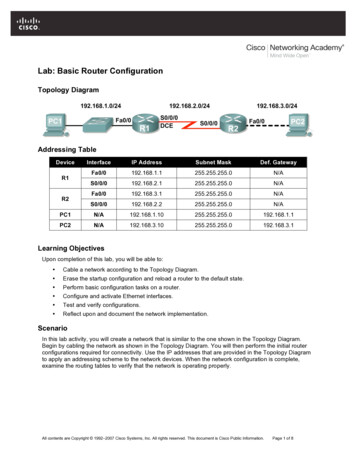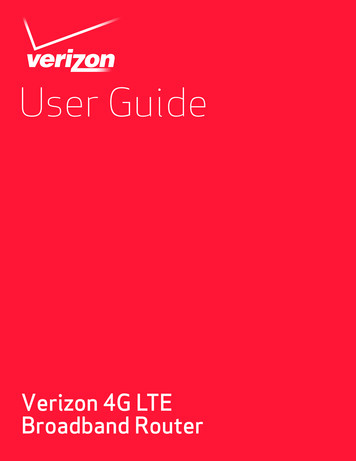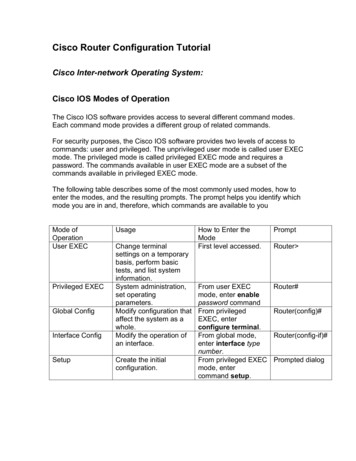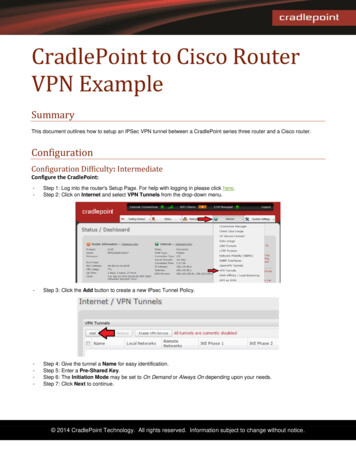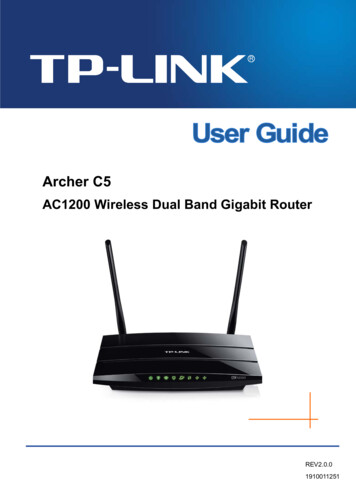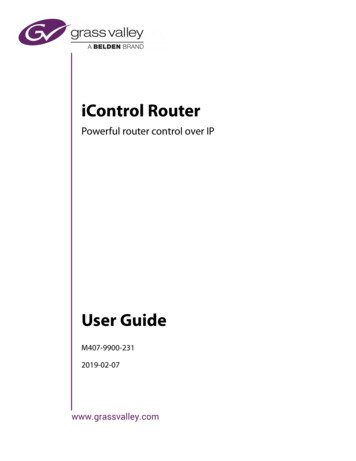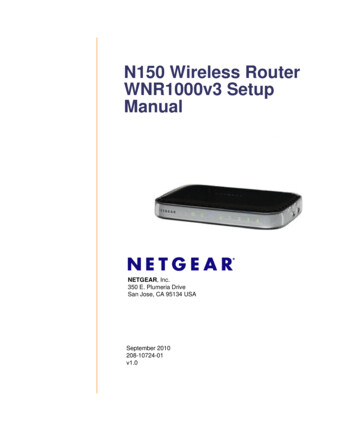
Transcription
N150 Wireless RouterWNR1000v3 SetupManualNETGEAR, Inc.350 E. Plumeria DriveSan Jose, CA 95134 USASeptember 2010208-10724-01v1.0
2010 by NETGEAR, Inc. All rights reserved.TrademarksNETGEAR and the NETGEAR logo are trademarks of NETGEAR. Inc. Microsoft, Windows, and Windows NT areregistered trademarks of Microsoft Corporation. Wi-Fi Protected Setup is a trademark of the Wi-Fi Alliance. Otherbrand and product names are registered trademarks or trademarks of their respective holders.Statement of ConditionsIn the interest of improving internal design, operational function, and/or reliability, NETGEAR reserves the right tomake changes to the products described in this document without notice.NETGEAR does not assume any liability that may occur due to the use or application of the product(s) or circuitlayout(s) described herein.ii
ContentsN150 Wireless Router Setup ManualGetting to Know Your Wireless Router. 1Unpacking Your New Router . 1Hardware Features . 2Front Panel . 2Back Panel . 4Side Panel . 4Router Label . 5Positioning Your Wireless Router . 5Installing Your Wireless Router . 6Updating Your Router Firmware . 7Installing Your Router Using the Smart Wizard . 8Using the Smart Wizard . 8Accessing Your Router After Installation . 10Manually Installing Your Router . 11Connecting Your Wireless Router . 12Verifying Your Connection . 15Setting Up Your Router for Internet Access . 16Configuring Your Wireless Network. 20Setting Your SSID and Wireless Security . 21Using Push 'N' Connect (WPS) to Configure Your Wireless Network .22Troubleshooting. 24Basic Setup Checklist . 24Checking Basic Router Functions . 25Troubleshooting Login Problems . 27Checking the Internet Service Connection . 28iii
Obtaining an Internet IP Address . 28Troubleshooting PPPoE . 29Troubleshooting Internet Browsing . 30Using the Ping Utility to Troubleshoot . 30Testing the Path from Your Computer to Your Router . 30Testing the Path from a Computer to the Internet . 31Technical Specifications . 32Default Configuration Settings . 32Restoring the Default Password and Configuration Settings . 34Related Documents . 35Registration and Certifications. 36iv
Getting to Know Your Wireless RouterCongratulations on your purchase of a NETGEAR high-speed wireless router, the N150Wireless Router Model WNR1000v3.Before you begin installing your router, check the package contents (see “Unpacking Your NewRouter” on page 1). Become familiar with the front and back panels of your router—especially thestatus lights—and the important information on the router label (see “Hardware Features” onpage 2). Then, read the section on “Positioning Your Wireless Router” on page 5 to ensure thatyou have selected the best location to install your router.Unpacking Your New RouterYour product package should contain the following items: The N150 Wireless Router An AC power adapter (varies by region) A yellow Ethernet cable NETGEAR Installation Guide The Resource CD, which includes:–The Smart Wizard Installation Assistant (Autorun.exe)–A PDF version of this manual–A link to the online User ManualA link to the online User Manual is also available from the router interface,after the router is installed. Click Documentation on the main menu.If any of the parts are incorrect, missing, or damaged, contact your NETGEAR dealer. Keep thecarton, including the original packing materials, in case you need to return the product for repair.Getting to Know Your Wireless Router1
To prepare your router for installation:1. Carefully peel off any protective film covering the sides of your router.2. Place your router in a suitable area for installation (near an AC power outlet and accessible tothe Ethernet cables for your wired computers).Hardware FeaturesBefore you install and connect your router, take a moment to become familiar with the front andback panels of the router—especially the status lights on the front panel.Front PanelThe router front panel, shown in Figure 1, contains status lights. (For more information oninterpreting the status lights, see “Verifying Your Connection” on page 15 and “Checking BasicRouter Functions” on page 25.)12345Figure 1Getting to Know Your Wireless Router2
You can use the status lights to verify various conditions.Table 1.Status Light DescriptionsLabel1. Power2. Push 'N'Connect3. Internet4. WirelessActivityDescriptionSolid AmberThe router is performing the power-on self-test diagnostic.Solid GreenThe power is on and the router is ready.Blinking AmberA software update is in progress.Blinking GreenFirmware is corrupted. See “Checking Basic Router Functions” onpage 25 for instructions on restoring your router firmware.OffPower is not being supplied to the routerSolid GreenIndicates that wireless security is enabled.Blinking GreenA WPS-capable device is connecting to or managing the router.OffNo WPS connection exists.Solid AmberThe Internet port is connected, but no IP address has been acquired.Solid GreenThe wireless router has acquired an Internet address.BlinkingData is being communicated through the Internet port.OffNo Ethernet cable is connected to the modem.Solid BlueThe wireless interface is enabled.Blinking BlueData is being communicated over the wireless network.OffThe wireless interface is turned off.Solid GreenThe local port is connected to a 100 Mbps device.Blinking GreenData is being transmitted at 100 Mbps.5. LANSolid Amber(Ports 1–4)Blinking AmberOffGetting to Know Your Wireless RouterThe local port is connected to a 10 Mbps device.Data is being transmitted at 10 Mbps.No link is detected on this port.3
Back PanelThe router back panel, shown in Figure 2, contains port connections.12345Figure 2Viewed from left to right, the rear panel contains the following elements:1. Restore factory settings button. Press for approximately 5 seconds to reset the router to thefactory default settings.2. Four Local Area Network (LAN) 10/100 Mbps Ethernet ports for connecting the router toyour local computers3. Internet/Wide Area Network (WAN) Ethernet port for connecting the router to a cable or DSLmodem.4. Power on/off push-button.5. AC power adapter outlet for connecting the power adapter.Side PanelThe router side panel is shown in Figure 3.12Figure 3Getting to Know Your Wireless Router4
1. WPS button – Turns Push ‘N’ Connect (WPS) on and off. When Push ‘N’ Connect is activeand ready to add a wireless client through WPS, the Push ‘N’ Connect LED on the front of thewireless router is blinking. See “Push 'N' Connect” on page 3.2. Wireless On/Off button – Turns the Wireless network on and off. When the Wirelessnetwork is enabled, the Wireless LED on the front of the router is solid blue. See “Wireless”on page 3.Router LabelThe label on the bottom of the wireless router shows the router’s MAC address, serial number,security PIN, and factory default login information.The ports on the router are color-coded to distinguish your Internet port from the other four portsthat connect to the wired computer(s) on your Local Area Network (LAN).Figure 4Positioning Your Wireless RouterThe wireless router lets you access your network from virtually anywhere within the operatingrange of your wireless network. However, the operating distance or range of your wirelessconnection can vary significantly depending on the physical placement of your router. Forexample, the thickness and number of walls the wireless signal must pass through might limit therange. For best results, place your router: Near the center of the area where your computers and other devices will operate, preferablywithin line of sight to your wireless devices.Getting to Know Your Wireless Router5
Accessible to an AC power outlet and near Ethernet cables for wired computers. In an elevated location such as a high shelf, keeping the number of walls and ceilings betweenthe wireless router and your other devices to a minimum. Away from electrical devices which are potential sources of interference, such as ceiling fans,home security systems, microwaves, or the base for a cordless phone. Away from any large metal surfaces, such as a solid metal door or aluminum studs. Largeexpanses of other materials such as glass, insulated walls, fish tanks, mirrors, brick, andconcrete can also affect your wireless signal.Failure to follow these guidelines can result in significant performance degradationor an inability to wirelessly connect to the Internet.Installing Your Wireless RouterTo help you set up your router and get on the Internet quickly, the Resource CD contains a SmartWizard Installation Assistant. The Installation Assistant walks you through the steps required toconnect your router, modem, and PC(s); configure your wireless settings; and enable wirelesssecurity for your network. When you have finished, you will be Internet ready!NETGEAR does not recommend or support adding a NETGEAR router behindanother router, or replacing a gateway with a NETGEAR router.If you have a Linux system, you need to use the manual installation method (see“Manually Installing Your Router” on page 11).You can set up your wireless router using one of two methods: Smart Wizard Setup: The Smart Wizard Installation Assistant setup is available on yourResource CD. See “Installing Your Router Using the Smart Wizard” on page 8 to use theSmart Wizard Installation Assistant.Getting to Know Your Wireless Router6
This is the easiest option. The wizard guides you through the setup process. It automates manyof the steps and verifies that the steps have been successfully completed.Before running the Smart Wizard Installation Assistant on a corporate PC toset up your home router, check with your company’s network support staff.Corporate network settings or Virtual Private Network (VPN) clientsoftware might conflict with the default settings of a home router. If you areunsure about whether there might be a conflict, use a different computer. Manual Setup: If you cannot or prefer not to use the Smart Wizard Installation Assistant, see“Manually Installing Your Router” on page 11. For example, if you are using a Linuxoperating system or are technically knowledgeable, select this option. If you choose to use thisoption and install your router manually, for best results, install and set up your router in thisorder:1. Install and connect your wireless router to your network (see “Connecting Your WirelessRouter” on page 12).2. Set up your wireless router for Internet access (see “Setting Up Your Router for InternetAccess” on page 16).3. Configure your wireless network and select wireless security settings to protect yourwireless network (see “Configuring Your Wireless Network” on page 20).Updating Your Router FirmwareNETGEAR is always improving the operability and features included with your router. To make iteasy for you to receive the best, most up-to-date features of your router, NETGEAR provides avariety of methods for updating your product. The Smart Wizard Installation Assistant lets you check for and install updates as part of thesetup activity (see “Using the Smart Wizard” on page 8). The router includes an update feature that lets you check for and install updates. You must login to the router to use this feature see “Setting Up Your Router for Internet Access” onpage 16, or the online User Manual).Getting to Know Your Wireless Router7
Installing Your RouterUsing the Smart WizardThe Smart Wizard setup procedure should take about 15 minutes to complete. Before using theSmart Wizard, ensure that: You are using a PC with either a Mac operating system or a Windows operating system(Windows 7, Windows Vista, Windows 2000, or Windows XP with Service Pack 2); and awired Ethernet connection, not a wireless connection. You have an Internet service connection through an Internet Service Provider (ISP). You have the configuration information provided by your ISP.Using the Smart WizardThe NETGEAR Smart Wizard takes you through the procedure to connect your router, modem,and PC(s). It then helps you to configure your wireless settings and enable wireless security foryour network. The Smart Wizard guides you through the setup process by automating many of thesteps. At each step in the setup process, the Smart Wizard checks to ensure that the steps youperform are successfully completed.To set up your router using the Smart Wizard:1. To start the Smart Wizard: For Windows users,–Insert the Resource CD into your PC. The CD will automatically start and detect thelanguage you are using on your PC. Select a different language option, if you prefer.If the CD does not automatically start, browse the CD and double-clickon.– In the CD’s menu, click Setup to start the Smart Wizard.For Mac users, double-click the MacWizard program.Installing Your Router Using the Smart Wizard8
2. When the Smart Wizard prompts you about updates, click Yes to check for updates for yourrouter, or No, to update later (for more information, see “Setting Up Your Router for InternetAccess” on page 16, or the online User Manual).3. Follow the remaining instructions and prompts.The Smart Wizard guides you through installing your router, connecting your router to theInternet, configuring your wireless network settings, and selecting the optimum securityprotection for your network. If you choose not to select a security option during installation,you can always access the router’s user interface later to select a security option (see“Configuring Your Wireless Network” on page 20).To ensure optimum performance of your high-speed wireless router, thewireless adapter card for each computer in your network should support thesame technology as your router. For more information, see the online UserManual.At the close of installation: For Windows users, the Smart Wizard places a Router Setup.html file on yourcomputer’s desktop so that you can view the router settings. It also places the RouterLoginshortcut on the desktop for you to access the router’s main menu. For Mac users, the Smart Wizard places a Router Setup.pdf file on your desktop.You are now connected to the Internet.Figure 5To set up additional wireless computers in your network to access the router and connect to theInternet, see “Configuring Your Wireless Network” on page 20.Installing Your Router Using the Smart Wizard9
Accessing Your Router After InstallationThe Smart Wizard only appears when you first install the router or when the router is in its factorydefault state (for example, if you have reset the router to its default factory settings). If you want tochange the settings after installing and configuring your router using the Smart Wizard, you mustopen a browser window and log in to the router. You will also be prompted to check for new routerfirmware. For more information, see “Configuring Your Wireless Network” on page 20.Installing Your Router Using the Smart Wizard10
Manually Installing Your RouterBefore installing and connecting your router manually, review the list below and make sure thatyou have all of the necessary information.Use the procedures in this topic if you are an advanced user, or are installing on aLinux systems. Internet service connection through an Internet Service Provider (ISP).The configuration information your ISP gave you. Depending on how your Internet accountwas set up, you might need the following information to set up your wireless router and accessthe Internet:–Host and domain name–Internet login name and password (frequently an email address and password)–Domain Name Server (DNS) addresses–Fixed or static IP addressYour ISP should have provided you with all the information needed to connect to the Internet.If you cannot locate this information, ask your ISP. If you have cable modem service, make sure that you are using the same computer on whichyou first set up your Internet account.If you have not already done so: Check the package contents of your router to ensure that it is complete (see “Unpacking YourNew Router” on page 1). Select an optimum location for your wireless router after reviewing the guidelines presented in“Positioning Your Wireless Router” on page 5.Manually Installing Your Router11
Connecting Your Wireless RouterBefore you install your wireless router, make sure that the Internet Protocol (TCP/IP) Propertysettings on your computer are set to “automatically obtain an IP address” using DHCP and “ObtainDNS server address automatically.” You can check these settings by looking at the TCP/IPProperties of your Internal Network Connections, which are accessible through the Control Panelof your computer. If you are unsure about this, refer to the documentation for your computer or seethe link to TCP/IP Addressing in “Related Documents” on page 35.If you are replacing an existing router, disconnect it completely from your network and set it asidebefore starting to install your new router. Then, skip to step 5 in the following procedureNETGEAR does not recommend or support adding a NETGEAR router behindanother router, or replacing a gateway with a NETGEAR router.To connect the wireless router, the computer, and the modem:1. Turn off your computer.2. Turn off and unplug the cable or DSL broadband modem.3. Locate the cable (A) that connects your computer to the modem.4. Disconnect the cable at the modem end only (B). You will connect it to the router later.ABFigure 6Manually Installing Your Router12
5. Locate the Ethernet cable that came with your NETGEAR product. Securely insert one end ofthe Ethernet cable into your modem (C) and the other end into the Internet port of the wirelessrouter (D). (The cable and the Internet port label are color coded.)CDFigure 76. Locate the cable (A) that is still attached to your computer (see step 4). Securely insert thatcable into a port on the router, such as port 4 (E), as shown in Figure 8.AE4 3 2 1Figure 8Manually Installing Your Router13
7. Connect any additional wired PC to your router by inserting an Ethernet cable from one ofthese computers into one of the three remaining LAN ports.8. Review that your network is now set up (as shown in Figure 9); you are ready to start yournetwork.Figure 99. Start your network in the correct sequence, as described below.Failure to start or restart your network in the correct sequence could prevent youfrom accessing the Internet.To start your network:1. Plug in and turn on the cable or DSL modem. Wait 2 minutes.2. Plug the end of the power adapter’s cord into the wall or a power strip, and into the poweradapter outlet of your wireless router (F), as shown in Figure 10. Wait 1 minute.FFigure 10Manually Installing Your Router14
3. Turn on your computer. It will take several minutes for your router to establish a connectionwith your computer and your Internet provider.For DSL customers, if software logs you in to the Internet, do not run thatsoftware. You might need to go to the Internet Explorer Tools menu, InternetOptions, Connections tab and select “Never dial a connection.”Verifying Your ConnectionVerify that your router is connected correctly by checking the wireless router status lights (asillustrated in Figure 11).Figure 11Table 2.Status Lights After InstallationLabelDescription1. PowerThe power light should turn solid green. If it does not, see “Checking Basic RouterFunctions” on page 25.2. Push 'N' ConnectThe WPS button/light will not be lit unless you have set wireless security. See“Using Push 'N' Connect (WPS) to Configure Your Wireless Network” on page 22.3. WirelessThe wireless light should be lit after turning on the wireless router.Manually Installing Your Router15
Table 2.Status Lights After Installation (continued)LabelDescription4. InternetThe Internet port light should be lit. If it is not, make sure the Ethernet cable issecurely attached to the wireless router Internet port and the modem, and that themodem is powered on.5. LAN(Ports 1–4)A LAN light should be lit for each connected computer on your network. Greenindicates that your computer is communicating at 100 Mbps; amber indicatescommunication at 10 Mbps. If a LAN light is not lit for each connected Ethernetcable, make sure that the Ethernet cable from the computer to the router is securelyattached at both ends, and that the computer is turned on.Setting Up Your Router for Internet AccessWhen configuring your wireless router manually, you must log in to your wireless router to set itup initially and to make any changes to your wireless router’s settings later.The factory default state is reset when you use the Restore Factory Settings button.See “Restoring the Default Password and Configuration Settings” on page 34 formore information.To access the router:1. Type http://www.routerlogin.net in the address field of your browser, and then click Enter.You can enter either of these addresses to connect to your wireless router:http://www.routerlogin.net or http://www.routerlogin.com.A login window similar to the one shown in Figure 12 will display.Manually Installing Your Router16
Figure 122. When prompted, enter admin for the router user name and password for the router password,both in lowercase letters. (For security reasons, the router has its own user name andpassword.)The router user name and password are not the same as any user name orpassword you might use to log in to your Internet connection.The Firmware Upgrade Assistant screen will display.3. Click Yes to check for new firmware (recommended). The router will automatically check theNETGEAR database for a new firmware image file. If no new firmware version is available,the message “No New Firmware Version Available” will display. (If you select “No,” you cancheck for new firmware later; see the online User Manual.)4. If new firmware is available, click Yes, and the router will automatically upgrade itself withthe latest firmware.Do not try to go online, turn off the router, shut down the computer, or doanything else to the router until the router finishes restarting! When the Powerlight stops blinking, wait a few seconds more before using the router.Manually Installing Your Router17
5. From the menu options in the left navigation pane, click Setup Wizard. The Setup Wizardscreen will display.Figure 136. Select one of the following options: Select Yes to allow the Setup Wizard to detect your Internet connection. When prompted,click Next. The wizard will assist you with configuring your wireless router to access theInternet.If you cannot connect to the wireless router, check the Internet Protocol(TCP/IP) properties in the Network Connections section of your ControlPanel. It should be set to obtain both IP and DNS server addressesautomatically. For assistance, see your computer documentation or see thelinks in “Related Documents” on page 35. Select No to set up the connection yourself. Click Next and the Basic Settings screen willdisplay. Enter the required information for your ISP connection in the appropriate fields. Ifyou need assistance, follow the Basic Settings Help screens on the router interface or seethe online User Manual for this wireless router.For more information about configuring settings, see “Configuring YourWireless Network” on page 20.7. Click Apply to save your settings and complete your connection.You should now be connected to the Internet!Manually Installing Your Router18
If you do not connect successfully: Review your settings and make sure that you have selected the correct options and typedeverything correctly. Contact your ISP to verify that you have the correct configuration information. Read “Troubleshooting” on page 24.If problems persist, register your NETGEAR product and contact NETGEAR Technical Support.Manually Installing Your Router19
Configuring Your Wireless NetworkAfter installing your Router, you must log into the Router to complete your wireless setup. Thewireless network settings of the Router must match the wireless network settings of any wirelessdevices that connect wirelessly to the Router (such as wireless adapter cards and wirelesscomputers).For a wireless connection, the router and each wireless computer must use the same SSID, alsocalled the wireless network name, and the same wireless security. NETGEAR stronglyrecommends that you use wireless security.Indoors, computers can connect over wireless networks at a range of several hundredfeet. This can allow others outside of your immediate area to access your network.The Wireless Settings screen lets you set your wireless network connections and the wirelesssecurity option for your network and router. To configure the wireless network, you can eithermanually specify your network name (SSID) and your wireless security settings (see “SettingYour SSID and Wireless Security” on page 21) or, if the clients in your network are WPS capable,you can use Wi-Fi Protected Setup (WPS) to automatically configure your router and, at the sametime, add the WPS-capable devices to your secure wireless network (see “Using Push 'N' Connect(WPS) to Configure Your Wireless Network” on page 22). You can also use Push 'N' Connect(WPS) to add WPS-capable devices after you have set your SSID and wireless security using themanual or traditional method (the preferred option).If you configure the router from a wireless computer and you change the router’sSSID, channel, or security settings, you will lose your wireless connection whenyou click Apply. You must then change your computer’s wireless settings to matchthe router’s new settings. To avoid this situation, you can use a computer that isconnected to the router with an Ethernet cable.For a complete overview of all the security configurations that can be implemented on this router,see the online User Manual. A link to the User Manual is on the Resource CD.Configuring Your Wireless Network20
Setting Your SSID and Wireless SecurityTo specify the wireless settings, you must know the following: SSID. The default SSID for the router is NETGEAR. The wireless mode (802.11g/b, or 802.11n) that each wireless adapter supports. Wireless security option. NETGEAR strongly recommends that you use wireless security. Tosuccessfully implement wireless security, check each wireless adapter to determine whichwireless security option it supports.To set up basic wireless connectivity:1. Log in to the Router by going to http://www.routerlogin.net or http://www.routerlogin.comand entering the default user name admin and default password password, or using whateverLAN address and password you have set up.You can also enter either of these addresses to connect to your wireless router:http://www.routerlogin.net or http://www.routerlogin.com.2. On the main menu, select Wireless Settings to display the Wireless Settings screen.Note that the default SSID is NETGEAR.The SSID of any wireless adapter must match the SSID you configure in thewireless router. If they do not match, you will not get a wireless connection.3. Set the Region. Select the region
2. Set up your wireless router for Internet access (see "Setting Up Your Router for Internet Access" on page 16). 3. Configure your wireless network and select wireless security settings to protect your wireless network (see "Configuring Your Wireless Network" on page 20). Updating Your Router Firmware

